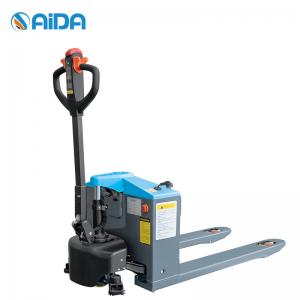
Add to Cart
Advantages
| Model | WCT15QC |
| Load capacity | 1500kg |
| Rear Wheel Base | 390/520mm |
| Max.lifting height | 190mm |
| Lowered fork Height | 75/85mm |
| Overall length | 1626mm |
| Overall width | 550mm |
| Travel speed | 4.2/4.5 km/h |
| Gradient,Laden/unladen | 6/10% |
| Drive motor | 750w |
| Lift motor | 800w |
| Battery | Lead-acid 24V 65Ah Lithium 24V40Ah optional |
Structure Details

Do you need a license for an electric pallet truck?
No need a licence for operating an electric pallet truck
What is the difference between semi-electric pallet truck and fully electric pallet truck?
A semi-electric pallet truck and a fully electric pallet truck are both types of material handling equipment used for moving pallets and heavy loads. However, there are some key differences between the two:
Power Source: The main difference lies in the power source used to operate the pallet truck. A semi-electric pallet truck typically features an electric motor for driving the wheels, but manual operation is required for lifting and lowering the forks. In contrast, a fully electric pallet truck is powered entirely by an electric motor for both driving and lifting functions.
Lifting Mechanism: In a semi-electric pallet truck, the lifting of the forks (to raise or lower the load) is done manually by using a pump handle or a lever. The electric motor is only used for moving the truck and providing traction. On the other hand, a fully electric pallet truck incorporates an electrically operated hydraulic lifting mechanism, allowing for effortless lifting and lowering of the forks.
Load Capacity: Fully electric pallet trucks generally have a higher load capacity compared to semi-electric models. This is because the electric lifting mechanism in a fully electric pallet truck is designed to handle heavier loads more efficiently. Semi-electric pallet trucks are typically suitable for lighter loads.
Ease of Use: Fully electric pallet trucks offer greater convenience and ease of use since both the driving and lifting functions are electrically powered. The operator can control the lifting and lowering of the forks with the push of a button or a lever, making it less physically demanding. Semi-electric pallet trucks require more manual effort for lifting and lowering the forks.
Cost: Generally, fully electric pallet trucks tend to be more expensive than semi-electric pallet trucks. The additional cost is associated with the more sophisticated electric lifting mechanism and the convenience of having both driving and lifting functions powered by electricity.
When deciding between a semi-electric and fully electric pallet truck, it is essential to consider factors such as load capacity requirements, frequency of use, operator convenience, and budget constraints.